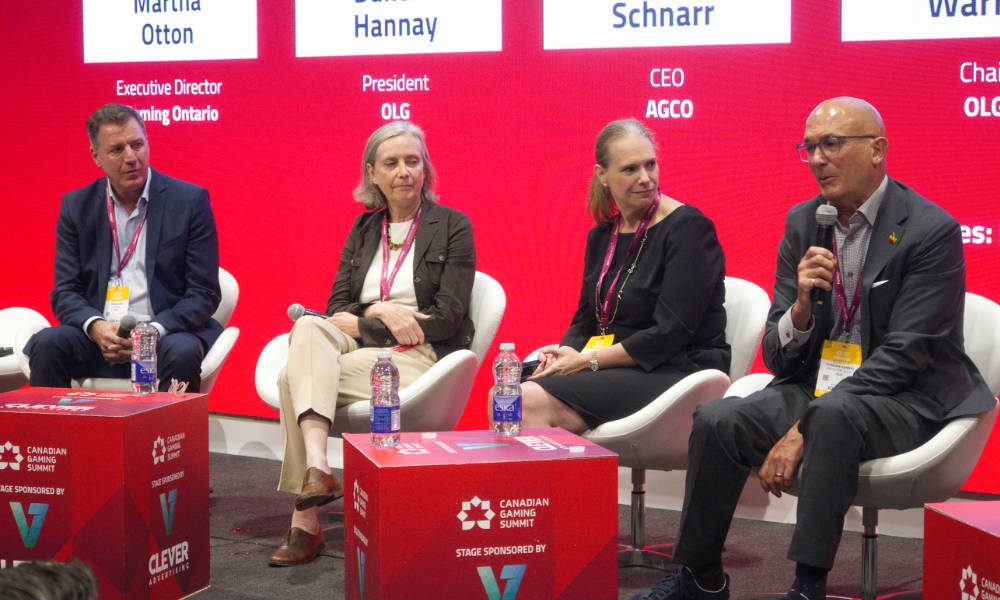Insights from Ontario’s igaming power brokers on the state of the provincial market have become a staple in panel discussions at the annual Canadian Gaming Summit and this year’s event didn’t disappoint.
Martha Otton, Executive Director of iGaming Ontario, Duncan Hannay, President & CEO of Ontario Lottery and Gaming Corporation (the crown corporation that conducts and manages gaming in the province, including land-based lottery products and digital-gaming platforms), and Karin Schnarr, CEO, of the Alcohol and Gaming Commission of Ontario told a packed conference room at the Metro Toronto Convention Centre that there’s still room for market growth in Ontario
Otton had the results of the latest Deloitte economic development report in her hands.
In its second year of operation, Ontario’s regulated igaming market has 51 licensed operators, over 70 gaming sites, over 5,000 games approved, has sustained nearly 15,000 jobs, and has added a combined $1.24 billion to federal, provincial, and municipal revenues, according to Deloitte’s “Economic Contributions of Ontario’s Regulated iGaming Market – Year 2 Report.”
The regulated igaming market contributed $2.7 billion to Ontario’s GDP in its second year of operation, up from $1.58 billion in Year 1. The Ontario market went live in April 2022.
At last year’s summit, Otton also spoke, bearing positive industry news. The challenges in the market remain: an active gray market, despite the fact 86 percent of players are on licensed platforms, and criticism that Ontario’s land-based casinos are restricted in embracing igaming and growing their businesses, like partnering with operators to launch sportsbooks. Still, the success of Ontario’s igaming market after two years and a few months is a testament to the province’s regulator, Ontario’s regulatory regime, and its compliance framework.
Here are some highlights from the Otton et al. talk at this week’s summit.
“Ontario’s a model to show what really can work if there’s that level of cooperation between governments and regulators and crown corporations,” said Schnarr. “As a regulator, I’m particularly pleased about making sure that we have those strong protectors in place and we see that in the rate of channelization. We’re not at 100 percent. It’s hard to get to 100 percent. And you know, we’ll have more dialogue about that. But we’re already at 86 percent. We’re seeing increases every year.
“We know that players want choice. We know that there’s all kinds of interesting and innovative products and we have an opportunity in Ontario to do that in a safe regulated way that benefits operators, the public, and the government.”
Said Hannay, “The other thing, as a competitor in the marketplace, is having a level playing field. We’re all playing by the same rulebook. That’s important. A level playing field is good for open competition. And that’s good for the province. The third thing that I would point to is that the market as it’s constructed is also driving economic development. It’s bringing jobs locally and it’s inspiring innovation. We’re seeing that across the industry.
“One of the fabulous things about digital gaming is that we have 100 percent known play on our platforms. So we have an enormous data set at our disposal. We know who our customers are and we have the tools and capabilities to identify when there’s risky play or when there may be problem play that we can identify, that we can help our customers understand healthy play.
“There probably will be some consolidation over time, but there’s still a large addressable market in Ontario. There’s still untapped opportunity within this market.”
Said Schnarr: “We forget sometimes that we’ve been in the market on the gaming side for only a little over two years. It feels like a mature market already, but we’re still very nascent in terms of what we’re doing. I was so impressed that my predecessor really spearheaded reforms and some additional standards on the advertising side related to celebrities and retired athletes and by the cooperation of the industry coming together and making sure that we’re adhering to those standards. That’s just an example of how we’re going to continue to evolve as an industry from a regulatory perspective.
“But as Martha said, the opportunities for regulators and conductors and managers, how can we continue to share data, how can we continue to make sure self-exclusion is more streamlined, how can we make sure that our systems make sense? How can we continue to make sure that we’ve got best practices related to responsible gaming?
“We’ve got a fantastic foundation to continue to launch from. I meet operators all the time. We already have 51 new business models, new client groups, customer groups. So we’re still at the beginning of that journey.”



